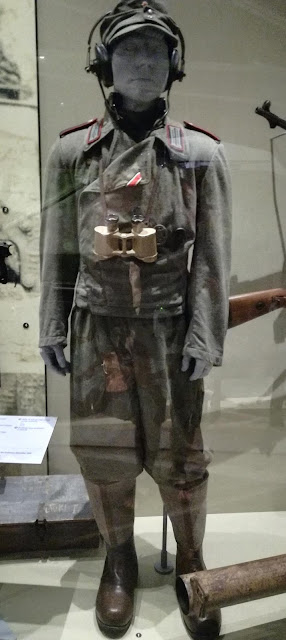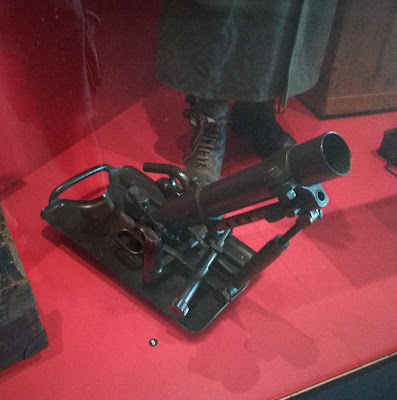A few days ago I managed to visit Bastogne. It's an eternal place for any military history fan and wargamer or model collector. In Bastogne much of the Ardennes German campaign was at stake as this city was the central point of seven converging roads. The Germans of the 5th Panzer Army of Hasso Von Manteuffel tried hard to win the city with the 26th Volksgrenadier Division and the Pz Lehr. The 2nd Pz Division, the Führer Gebleit Brigade and the 15th Pz Grenadier Division help the attackers but are not committed fully or are not present the whole time. But the stubborn resistance of the 101st Airborne Division, the 705th Tank Destroyer battalion and two Combat Command of the 9th and 10th Armored Divisions, among others, prevented the German breakthrough. The German superiority in men and material was almost 2 to 1, but laws of war say it should have been at least 3 to 1 when the enemy is dug in defensive positions so may be the destiny of the battle was sealed from the beginning as well as the whole Ardennes campaign.
Even so the Bulge affair was much not as one sided as we learned a few decades ago. Recent researches showed that Luftwaffe's Bodenplatte operation effectively managed to paralyze much of the allied aviation and when Patton's 3rd army arrived from the south it suffered enormous casualties. Patton even said in its diary, January 45, that 'the war still could be lost'. If it was not for the Russians anticipating its Vistula offensive in 15 days on US urgent request the German tank force would have at least inflicted plenty more casualties on the allies. The terrain of that part of Ardennes is almost perfect tank ground, with planes, rolling hills and plenty of places for ambushes and in the open the superior German tanks could have prevailed.
While arriving to Bastogne from the south you understand that the Germans had some initial advantage as the city lies in a valley well at the range of artillery placed in a higher gradient. Seven days later this advantage was gone as this south entrance would also be the entry point of Patton's 3rd army relief force.
In this picture you can see a Sherman M4A3 tank in the main square of Bastogne. It's the famous Barracuda destroyed by a 75mm shell from a PzIV on the side and a shot from a Panzerfaust on the rear that left scars that can still be seen. One of the crew members died and the other four were captured.
Here the Duckbills (extended end connectors) on Sherman tracks can be seen to advantage. They were used in snowy or muddy ground and served to increase the traction and stability of the vehicle. Its a detail we often forget to model in late Shermans who operated in winter 1944.
Not much of the city was left intact but in this picture the medieval Porte des Treves can still be seen relatively untouched. For a model of the city it is an important building as its one of the oldest in Bastogne.
These were some of the positions of the of the 506th Parachute Infantry Regiment. Far in the picture at Mont, looking south east, elements of both the Pz Lehr and 26 VGD made several attempts to conquer the city.
There are nowadays seven turrets of Sherman tanks in Bastogne. They stand were the German attacks were stopped. This picture was taken close to the previous one and this T23 76mm gun turret points to Longvilly/Neffe which is the approximate the same direction of the Bastogne War Museum.
This turret is also a memorial to CC B of the 10th AD and contains a short story of the events participated by the unit and its division into 'Teams'.
This other turret points to Marvie and to Pz Lehr positions and stands in the Rue de La Chapelle. The road nearby is the Chaussée D'Arlon (nowadays N30).
The thick mantlet of the 76mm gun. Attention at the inclination of the mantlet which many times is not correct on our 20mm models.
The tough side port of the turret. Visible are also the layers of armour of the T23 turret.
Close to the Bastogne War Museum you have this view to the North in the direction of Foy/Noville and 2nd Pz Div. lines. The US side was defended by elements of the 502nd and 506th PIR.
Inside the Bastogne War Museum you are greeted by Blockbuster, a 105mm support Sherman.
Not so lucky was Absentee, completely ripped apart by AP shells. The idea of the side (or front) US stars was really a bad idea!
A nicely preserved Willys Jeep.
Another well preserved Browning 1917 HMG used by the 101st Airborne.
The black uniform of the Panzer units. I think this one belonged to a reconnaissance unit as it has some yellow piping. Damn reflexive glass!!
Volksgrenadier camouflaged uniform. The individual weapon is the Sturmgewehr 44 a weapon that the Germans used massively in this campaign providing some infantry companies with extraordinary firepower.
The German M44 peas camo jacket associated with the SS but eventually used by the Heer's infantry in later stages of the war. This model holds the MG42 LMG.
A German Radio operator. Note that the antenna folds at different angles.
A Sturmgeschütz crew member with its distinctive light grey uniform.
A German Fallschirmjäger and an US infantry or paratrooper clad in winter dress.
The 50mm German mortar. Not easy to make as a 20mm model ...
The Panzerschreck RPzB54 impresses by its lenght, the height of a man. Note the dark green ammunition.
Transport boxes of Panzerfaust (small).
The MG42 in its tripod acting as HMG and the company mortar of 8cm.
The Fallschimjäger FG-42.
The famous Hetzer used in great numbers for the first time in this campaign. Each Volksgrenadier division had a company of them and they were also allocated to other Anti-tank units. This one is not a WW2 built as its a purchase from the Swiss army that bought them from the Czechs who continued its production after the war.
This ex-Swiss Hetzer (called G-13 by them ) has the Hinterhalt camouflage used extensively in the Ardennes campaign.
Detail of the rough seam on the Hetzer welded armour. Germans were famous for the quality of the finishing of their armour plates but remember that this one is a copy. There are at least two more Hetzers at Bastogne, one in the Rue de la Roche and another at the Bastogne Barracks under restauration.
Yes, we should paint our model tracks rust iron...
A late war Kübelwagen with the new 1,131cc engine.
The country side around Bastogne is made mainly of rolling hills permitting the close proximity between US and German lines in the week of 20 to 27 December 1944. This picture was taken from US lines looking at Marvie direction and to Pz Lehr Div. lines. The defenders were probably elements of the 326th Glider Infantry regiment.
Next: More German armour for the late war period.































Very well explained, good job!
ReplyDeleteThank you madam! And also thanks for keeping the kid while your husband was drooling around all these places :)
ReplyDelete